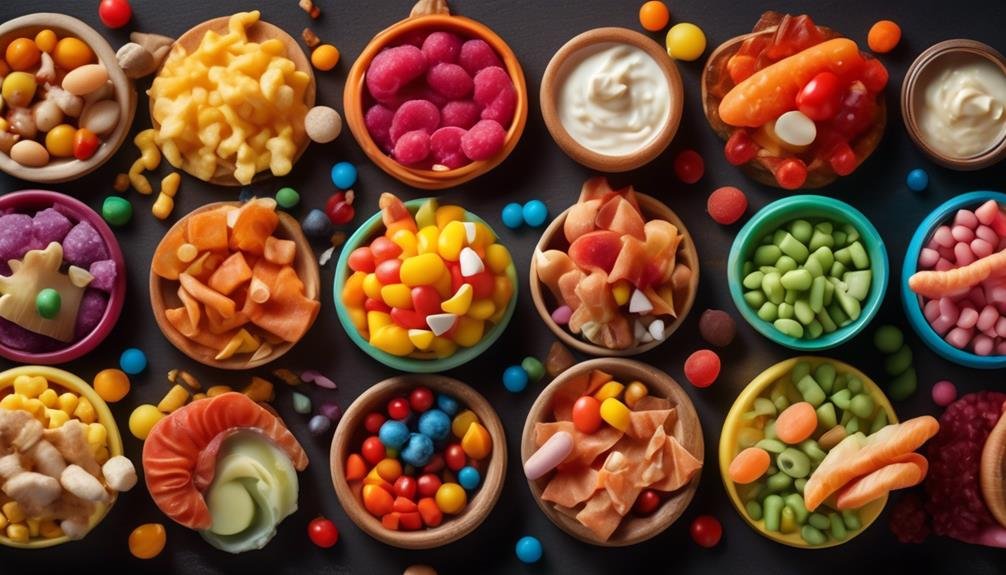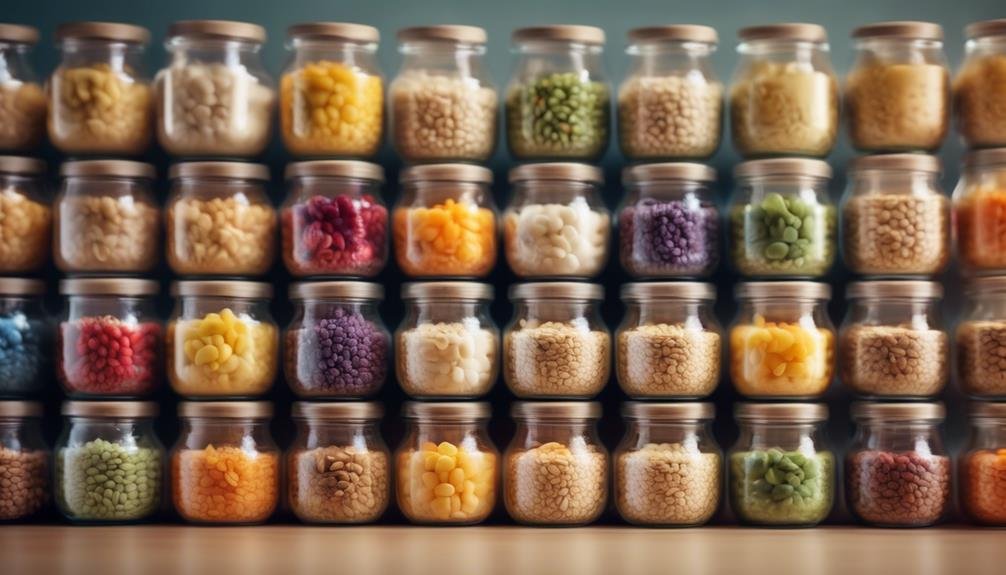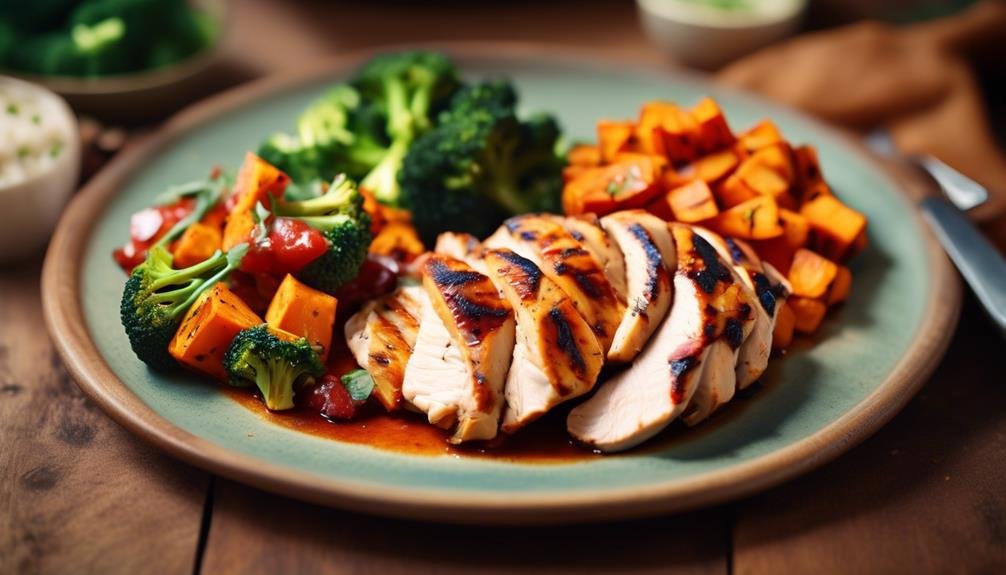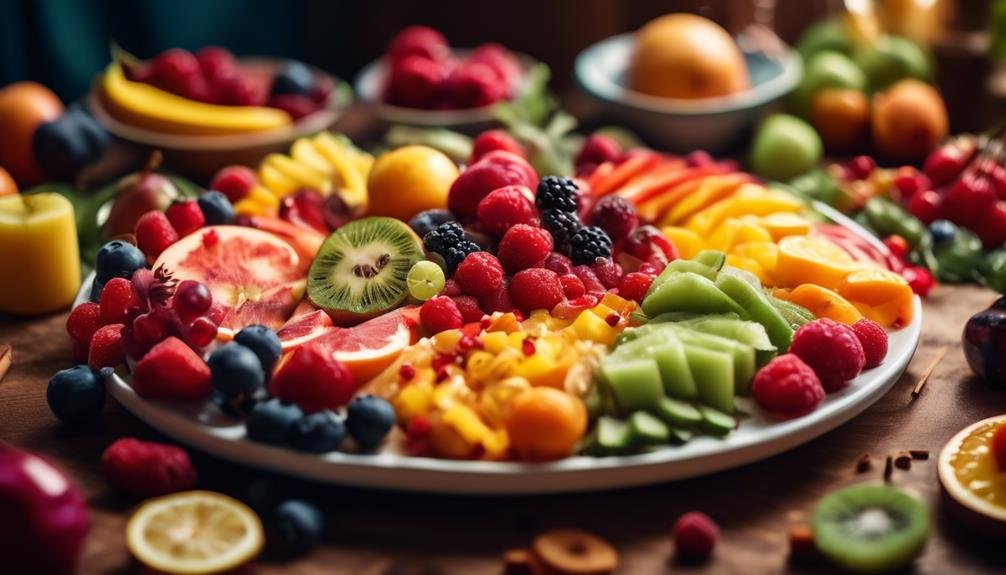9-Month-Old Meal Ideas
They say that variety is the spice of life, and this holds true even when it comes to feeding your 9-month-old. As your little one continues to explore the world of solid foods, it’s important to provide a range of nutritious options to support their growth and development.
But where do you start? In this article, we will share some enticing meal ideas that are not only suitable for your 9-month-old but also easy to prepare. From vegetable purees to protein-packed meals and finger foods for self-feeding, we’ve got you covered.
So, put on your apron and get ready to embark on a culinary journey that will keep your little one’s taste buds happy and their tummy satisfied.
Key Takeaways
- Vegetable purees are a nutrient-rich option that can be mixed with other purees or breast milk for taste and texture.
- Soft fruits and yogurt are nutritious options that can be mashed or pureed for easy consumption. They can also be mixed together to create fruit smoothies or yogurt parfaits.
- Introducing iron-rich purees, such as spinach and lentil puree or beetroot and quinoa puree, is important for growth and development.
- Finger foods and whole grain options, such as small pieces of soft fruits and vegetables or whole grain crackers with mashed avocado or hummus, can encourage self-feeding skills and provide a range of health benefits.
Vegetable Purees

To introduce a variety of vegetables into your 9-month-old’s diet, consider offering them nutrient-rich vegetable purees. Vegetable purees provide numerous nutritional benefits for your little one. They’re packed with essential vitamins, minerals, and fiber necessary for their growth and development.
When introducing vegetable purees to picky eaters, it’s important to be patient and persistent. Start by offering small amounts of pureed vegetables alongside familiar foods. You can mix them with other purees or even breast milk to enhance the taste and texture. Gradually increase the amount of vegetables over time to encourage acceptance.
Another tip is to make the purees visually appealing. Use vibrant and colorful vegetables like carrots, sweet potatoes, and spinach. You can also experiment with different flavors by combining various vegetables together. Adding a touch of herbs and spices can enhance the taste and make the purees more appealing to your little one.
Soft Fruits and Yogurt
For a delightful twist on your 9-month-old’s meal options, consider incorporating soft fruits and yogurt into their diet.
Soft fruits, such as bananas, peaches, and pears, aren’t only delicious but also packed with essential nutrients like vitamins C and A. They’re easy to mash or puree, making them perfect for your little one’s developing palate.
Yogurt, on the other hand, is an excellent source of protein, calcium, and probiotics, which help support a healthy gut.
To introduce soft fruits and yogurt to your baby, you can start by offering mashed fruits or fruit purees as standalone snacks or mix them with yogurt to create delicious fruit smoothies. Simply blend together your choice of soft fruits and a dollop of yogurt until smooth and creamy. Your baby will love the sweet and tangy taste of these refreshing treats.
Another option is to create yogurt parfaits by layering mashed fruits and yogurt in a small bowl or cup. This not only adds variety to your baby’s meal but also encourages them to explore different flavors and textures. You can even top it off with a sprinkle of baby-friendly granola or finely chopped nuts for added crunch.
Remember to choose plain, unsweetened yogurt and avoid adding any sweeteners or additives. Always consult with your pediatrician before introducing new foods to your baby’s diet, especially if they’ve any allergies or medical conditions.
Enjoy exploring these soft fruits and yogurt options with your little one and watch them savor every bite!
Iron-Rich Purees

Introducing iron-rich purees into your 9-month-old’s diet is essential for their growth and development. Iron is a vital nutrient that aids in the production of red blood cells and supports brain development. To ensure your little one gets enough iron, try these nutrient-dense purees:
- Spinach and lentil puree: Combine cooked lentils with steamed spinach for a powerhouse of iron. Lentils are rich in this essential mineral, while spinach provides additional vitamins and minerals.
- Beetroot and quinoa puree: Beets aren’t only sweet and colorful but also packed with iron. Cooked beets blended with cooked quinoa create a delicious and nutritious puree that your baby will love.
- Banana and chia seed smoothie: Chia seeds are a great source of iron, and combining them with bananas creates a creamy and nutritious smoothie. Simply blend ripe bananas with soaked chia seeds for a tasty iron-rich treat.
Remember to consult your pediatrician before introducing new foods to your baby’s diet. By incorporating these iron-rich purees, you can ensure your 9-month-old receives the necessary nutrients for optimal growth and development.
Protein-Packed Meals
Include protein-rich foods in your 9-month-old’s meals to support their growth and development. Lentils and tofu are excellent options that can be incorporated into your baby’s diet.
Lentils are a great source of plant-based protein and can be prepared in various delicious ways. You can try making lentil purees by boiling lentils until they become soft and then blending them into a smooth consistency. Lentil soup is another option that can provide both protein and essential nutrients.
Tofu, made from soybeans, is also a protein-packed food that can be introduced to your baby. It’s a versatile ingredient that can be used in a variety of dishes. Soft tofu can be mashed and mixed with fruits or vegetables to create a nutritious puree. You can also try baking or grilling tofu and cutting it into small, easy-to-eat pieces.
When preparing lentil recipes or tofu dishes for your 9-month-old, make sure to cook them thoroughly to ensure they’re easy to digest. It’s also important to introduce new foods gradually and watch for any signs of allergies or intolerance.
Finger Foods for Self-Feeding

Encourage your 9-month-old to explore and develop their self-feeding skills by introducing a variety of nutritious finger foods. This stage is crucial for their development, as it allows them to practice their fine motor skills and gain independence in mealtime.
Here are three healthy snacks and toddler-friendly recipes that you can try:
- Soft fruits and vegetables: Offer small pieces of ripe banana, avocado, steamed sweet potato, or cooked carrots. These soft and easily mashable foods are perfect for little hands to grasp and explore.
- Whole grain crackers or toast: Opt for whole grain options to provide fiber and nutrients. You can spread a thin layer of mashed avocado or hummus on top for added flavor and nutrition.
- Bite-sized protein: Introduce small pieces of cooked chicken, tofu, or beans. These protein-rich foods are essential for growth and development. Make sure they’re cooked until tender and cut into small, manageable pieces.
Remember to always supervise your child during mealtime and offer a variety of foods to ensure a balanced diet. Let them experiment and enjoy the process of self-feeding, fostering a positive relationship with food from an early age.
Whole Grain Options
Whole grain options provide essential fiber and nutrients for your 9-month-old’s growing body. Introducing whole grains at this stage is important as they offer a range of health benefits.
Whole grain pasta is a great option to incorporate into your baby’s meals. It’s made from whole wheat flour, retaining the bran and germ, which are rich in fiber and nutrients. You can prepare a simple pasta dish by boiling whole grain pasta until it’s soft and easily mashed. You can then mix it with cooked and mashed vegetables or protein sources like chicken or tofu.
Another option to consider is quinoa. Quinoa is a complete protein source, meaning it contains all essential amino acids. It’s also high in fiber, iron, and magnesium. You can prepare quinoa by boiling it in water or low-sodium broth until it’s soft and easily mashed. You can then mix it with pureed fruits or vegetables to create a nutritious meal for your little one.
Homemade Baby Cereals

To expand your 9-month-old’s culinary options, consider incorporating homemade baby cereals into their diet for added variety and nutritional benefits. Homemade baby cereals offer several advantages over store-bought options. They’re easy to prepare, allowing you to control the ingredients and ensure your little one is getting the nutrients they need.
Here are three reasons why homemade baby cereals are a great addition to your baby’s diet:
- Nutritional benefits: Homemade baby cereals are packed with essential nutrients, such as iron, zinc, and B vitamins. By making your own cereals, you can choose whole grains and organic ingredients, providing your baby with a healthier option than processed alternatives. Plus, you can easily introduce new flavors and textures by adding fruits or vegetables.
- Easy preparation: Making homemade baby cereals doesn’t have to be complicated or time-consuming. Simply grind up a small amount of whole grains, such as brown rice or oats, in a food processor or blender. Then, cook the grains with water or breast milk until they reach a smooth consistency. You can also make larger batches and freeze them in ice cube trays for future use.
- Cost-effective: Homemade baby cereals are budget-friendly compared to store-bought options. By buying whole grains in bulk and preparing them yourself, you can save money while providing your baby with nutritious meals.
Incorporating homemade baby cereals into your 9-month-old’s diet is a simple and effective way to introduce new flavors and provide essential nutrients. So why not give it a try? Your baby will love the variety, and you’ll have peace of mind knowing they’re getting the best start to a healthy diet.
Introduction to Dairy Products
Introduce a variety of dairy products to your 9-month-old’s diet for their growing nutritional needs. Dairy products provide numerous benefits for babies, including essential nutrients like calcium, protein, and vitamin D that are crucial for their bone development and overall growth.
When introducing dairy into your baby’s diet, it’s important to start with small amounts and gradually increase the serving size. Start by offering plain, whole milk yogurt or cottage cheese, as they’re easier for your baby to digest. You can also try introducing small amounts of cheese, such as mild cheddar or mozzarella, which can be cut into small, bite-sized pieces.
It’s recommended to wait until your baby is at least 12 months old before introducing cow’s milk as a beverage. However, you can use it in cooking and baking to add flavor and nutrients to your baby’s meals. Remember to always choose whole milk products, as the fat content is essential for your baby’s brain development.
As with any new food, watch for any signs of allergies or intolerances when introducing dairy products. If your baby experiences symptoms like rash, diarrhea, or vomiting, consult with your pediatrician.
Introducing dairy products to your 9-month-old’s diet can provide them with important nutrients for their growth and development. Start with small amounts and choose whole milk products to ensure their nutritional needs are met.
Balanced Meal Ideas

Once your 9-month-old has been introduced to dairy products, it’s important to provide them with balanced meal ideas that incorporate a variety of nutrients for their growing needs. Here are some toddler-friendly recipes that are quick and easy to make:
- Cheesy Veggie Omelette: Beat an egg with grated cheese and finely chopped vegetables like spinach, bell peppers, and mushrooms. Cook it in a non-stick pan until the egg is set and the cheese is melted. Cut it into small pieces for your little one to enjoy.
- Mini Turkey Meatballs: Mix ground turkey with breadcrumbs, grated zucchini, and a beaten egg. Roll the mixture into small balls and bake them in the oven until cooked through. Serve with a side of steamed veggies or whole grain pasta.
- Sweet Potato and Lentil Mash: Boil peeled and diced sweet potatoes with red lentils until tender. Drain and mash them together with a little bit of olive oil or unsalted butter. This delicious mash is packed with fiber, protein, and essential vitamins.
Remember to introduce new foods gradually and watch for any signs of allergies. These simple and nutritious meal ideas will help fuel your 9-month-old’s growth and development while providing them with a variety of flavors and textures to explore.
Creative Meal Combinations
Get creative with meal combinations for your 9-month-old to introduce new flavors and textures while ensuring they receive a balanced and nutritious diet. Meal prep for your little one can be fun and exciting, as you experiment with different ingredients and flavors.
Here are some toddler-friendly recipes that you can try:
- Sweet Potato and Lentil Mash: Cook sweet potatoes and lentils until tender, then mash them together for a delicious and nutrient-packed meal.
- Avocado and Banana Puree: Combine ripe avocados and bananas to create a creamy and nutritious puree that your little one will love.
- Quinoa and Vegetable Stir-fry: Cook quinoa according to package instructions, then stir-fry it with a variety of colorful vegetables for a tasty and nutritious meal.
- Apple and Carrot Muffins: Grate apples and carrots, then mix them into a muffin batter for a healthy and delicious snack.
- Spinach and Cheese Omelette: Whisk eggs with chopped spinach and grated cheese, then cook it into a fluffy omelette for a protein-packed meal.
Remember to introduce new foods gradually and watch for any signs of allergies or sensitivities. By getting creative with meal combinations, you can expand your little one’s palate and ensure they receive the nutrients they need for healthy growth and development.
Frequently Asked Questions
How Can I Introduce My Baby to Solid Foods for the First Time?
When introducing solid foods to your baby for the first time, consider baby-led weaning. It allows them to explore different textures and tastes at their own pace, promoting independence and healthy eating habits.
What Are Some Safe and Appropriate Finger Foods for My Month-Old Baby?
You’re looking for safe and appropriate finger foods for your month-old baby. It’s important to introduce solids gradually, starting with soft options like mashed avocado or cooked sweet potato.
Are There Any Specific Nutrients I Should Be Focusing on When Preparing Meals for My Baby?
When preparing meals for your baby, focus on nutrient-rich foods that support their growth and development. Consider incorporating a variety of fruits, vegetables, whole grains, and lean proteins. Also, establish a regular feeding schedule to promote healthy eating habits.
Can I Incorporate Store-Bought Baby Food Into My Baby’s Diet?
Using store-bought baby food as a supplement in your baby’s diet can be safe, but it’s important to consult with your pediatrician. Introducing solid foods at one month old is not recommended.
How Can I Ensure That My Baby Is Getting a Balanced and Nutritious Diet With These Meal Ideas?
You want to ensure your baby gets a balanced and nutritious diet. Start by focusing on balanced meal planning and nutrient-rich recipes. It’s important for their growth and development.
Conclusion
In conclusion, introducing a variety of nutritious meals to your 9-month-old is crucial for their growth and development.
From vegetable purees to finger foods for self-feeding, there are numerous options to explore. Remember to include iron-rich purees and protein-packed meals to meet their nutritional needs.
Get creative with meal combinations to keep your little one engaged and excited about eating. Just like a colorful palette, these meals will nourish your baby’s body and paint a picture of a healthy future.






